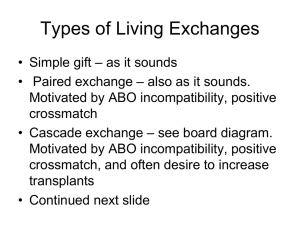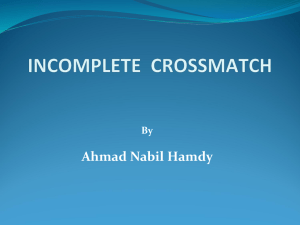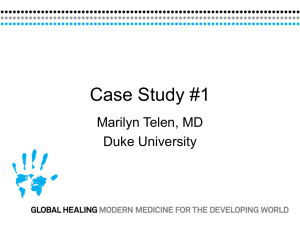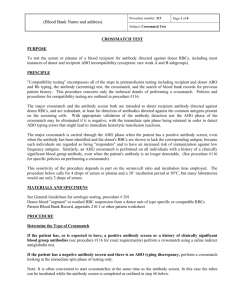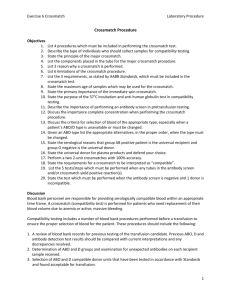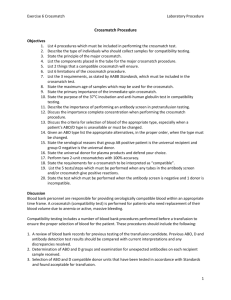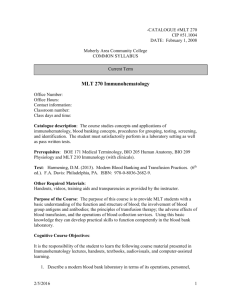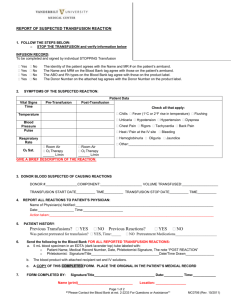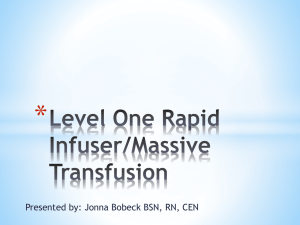Crossmatch Procedure: Blood Bank Compatibility Testing
advertisement
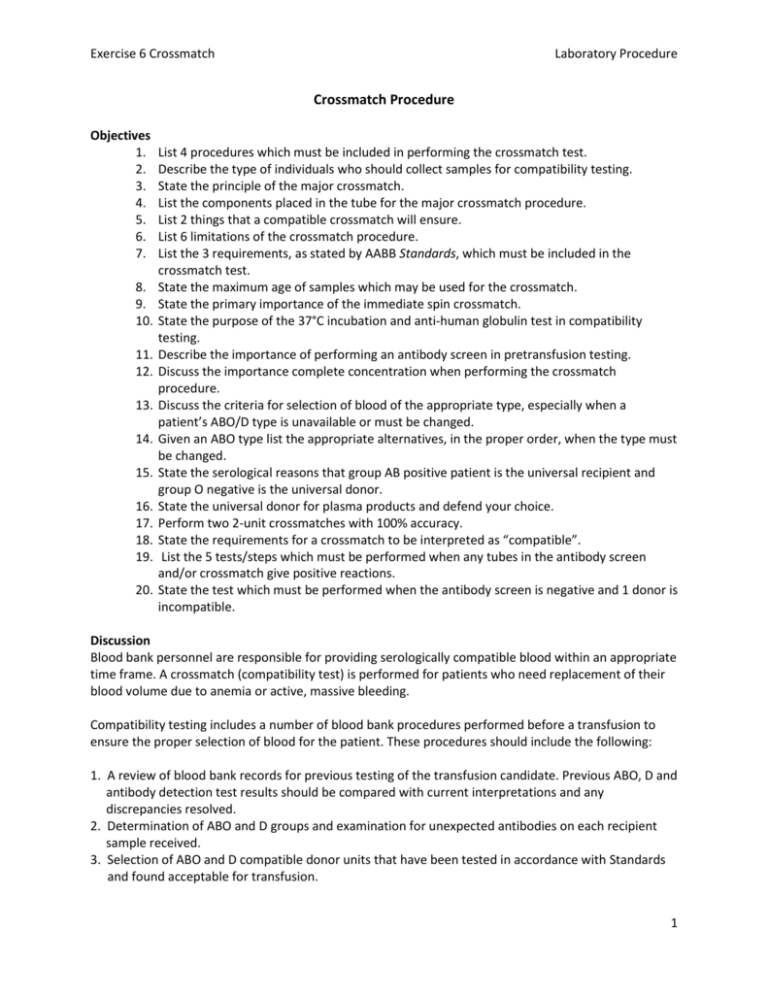
Exercise 6 Crossmatch Laboratory Procedure Crossmatch Procedure Objectives 1. 2. 3. 4. 5. 6. 7. 8. 9. 10. 11. 12. 13. 14. 15. 16. 17. 18. 19. 20. List 4 procedures which must be included in performing the crossmatch test. Describe the type of individuals who should collect samples for compatibility testing. State the principle of the major crossmatch. List the components placed in the tube for the major crossmatch procedure. List 2 things that a compatible crossmatch will ensure. List 6 limitations of the crossmatch procedure. List the 3 requirements, as stated by AABB Standards, which must be included in the crossmatch test. State the maximum age of samples which may be used for the crossmatch. State the primary importance of the immediate spin crossmatch. State the purpose of the 37°C incubation and anti-human globulin test in compatibility testing. Describe the importance of performing an antibody screen in pretransfusion testing. Discuss the importance complete concentration when performing the crossmatch procedure. Discuss the criteria for selection of blood of the appropriate type, especially when a patient’s ABO/D type is unavailable or must be changed. Given an ABO type list the appropriate alternatives, in the proper order, when the type must be changed. State the serological reasons that group AB positive patient is the universal recipient and group O negative is the universal donor. State the universal donor for plasma products and defend your choice. Perform two 2-unit crossmatches with 100% accuracy. State the requirements for a crossmatch to be interpreted as “compatible”. List the 5 tests/steps which must be performed when any tubes in the antibody screen and/or crossmatch give positive reactions. State the test which must be performed when the antibody screen is negative and 1 donor is incompatible. Discussion Blood bank personnel are responsible for providing serologically compatible blood within an appropriate time frame. A crossmatch (compatibility test) is performed for patients who need replacement of their blood volume due to anemia or active, massive bleeding. Compatibility testing includes a number of blood bank procedures performed before a transfusion to ensure the proper selection of blood for the patient. These procedures should include the following: 1. A review of blood bank records for previous testing of the transfusion candidate. Previous ABO, D and antibody detection test results should be compared with current interpretations and any discrepancies resolved. 2. Determination of ABO and D groups and examination for unexpected antibodies on each recipient sample received. 3. Selection of ABO and D compatible donor units that have been tested in accordance with Standards and found acceptable for transfusion. 1 Exercise 6 Crossmatch Laboratory Procedure 4. Crossmatching tests between patient serum and donor red cells for evidence of serologic incompatibility. Scientific and technical advances in blood group immunology have made the transfusion of blood a relatively safe procedure, but serious adverse effects of transfusion still result because of human error. Only individuals who understand the importance of blood bank protocols and adhere to them should be allowed to collect patient samples or perform tests. Failure to concentrate completely and use of careless techniques in performing laboratory tests directly endanger the life of the patient. The purpose of crossmatching is to prevent the transfusion of incompatible cells. Testing of the recipient's (patient) serum with donor cells (“major crossmatch”) is required because it is the best available way to detect antibodies in the patient serum that might damage transfused red cells and cause hemolytic transfusion reactions. When performed properly, a compatible crossmatch will: 1. verify, in most instances, that donor's red cells are ABO compatible with the patient; and 2. detect most antibodies in the recipient's serum directed against antigens on the donor red cells. The crossmatch has many limitations. A compatible crossmatch will not: 1. guarantee normal survival of transfused RBCs; 2. prevent immunization of the recipient; 3. detect all unexpected red blood cell antibodies in the recipient serum; 4. prevent delayed hemolysis due to an anamnestic antibody response to antigens against which the patient has previous but undetectable immunization; 5. detect all ABO grouping errors either in donor or recipient; and 6. detect most D grouping errors in the donor or recipient. Principle Standards requires that tests for serologic incompatibility employ methods that demonstrate ABO incompatibility, detect clinically significant antibodies active at 37°C, and include the antiglobulin tests. The patient specimen must be less than 72 hours old for compatibility testing so that it represents the current immunologic status of the patient. The major crossmatch involves testing the patient's serum with donor cells to determine whether the patient has an antibody which may cause a hemolytic transfusion reaction or decreased cell survival of donor cells. Of greatest importance is detection of ABO incompatibilities. ABO problems quickly become apparent when the mixture of patient's serum and donor cells is examined after centrifugation (immediate spin crossmatch). Unexpected cold reacting antibodies may also become apparent at this step, but once identified as such, they are usually considered insignificant. The crossmatch is incubated at 37°C to detect clinically significant agglutinating or hemolyzing antibodies. After incubation and washing, antiglobulin serum (Coomb's serum) is employed to detect antibodies that have attached to cells without causing agglutination (sensitization). Additional solutions such as albumin, polymerized albumin or low ionic salt solutions (LISS) are frequently employed to increase the sensitivity of the crossmatch or to reduce the incubation time. By 2 Exercise 6 Crossmatch Laboratory Procedure lowering the ionic strength or increasing the dielectric constant of the test medium, these solutions increase antibody uptake and enhance the strength of the antigen-antibody reaction. An antibody screen is performed along with the major crossmatch. The antibody screen is important in detecting weak antibodies which may only react with the homozygous screen cells or to detect antibodies directed against antigens present on the reagent screen cells but not present on the donor cells. It cannot be stressed enough that complete concentration and good technique must be used in blood bank procedures. Incorrect identification of specimens or materials or incorrect recording of results or interpretations cause false positives, false negatives and total disaster! Selection of Blood for Transfusion Whenever possible the blood selected for crossmatch should be of the same ABO and D group as that of the recipient. However, there are instances when it is acceptable or even advisable to transfuse red blood cells of a different ABO group, provided that they are compatible. For example: 1. When group and type specific blood is unavailable, as in transfusing group A blood to an AB recipient. 2. A patient, such as an A or B, is massively bleeding and depleting the type specific stock, there is a large number of group O units available, transfuse with group O. 3. For ABO and/or Rh hemolytic disease of the newborn. D positive individuals may receive D negative blood, although D negative units should be reserved for D negative patients. But a common sense approach to blood usage should be maintained. If you have an A positive "sure give", and you have 2 units of A negative expiring soon, it is a better use of the blood resources to give the 2 D negative to prevent their expiration. You would not make this decision on your own, but would confer with your coworkers or supervisor. D negative recipients should always receive D negative blood unless a life threatening situation arose. The doctor would need to sign a release form agreeing to the transfusion of D positive blood to this individual. Choice of Blood When Group Specific Blood is Unavailable When blood of the recipient's ABO group is unavailable, transfusion with an alternate group, as shown, is acceptable but must be administered as red blood cells. Note that for AB individuals the second choice lists group O as the next logical choice. Group B blood is relatively uncommon, you would not wish to deprive group B patients of type specific blood, so it makes more sense to choose group O, which is usually in abundant supply. Patient ABO Group A B AB A2B with anti-A1 O First Choice O O A A2 None Second Choice None None O or B O or B None 3 Exercise 6 Crossmatch Laboratory Procedure AB positive is considered to be the universal recipient for red cell transfusion. Due to their lack of ABO antibodies they will be compatible with all red blood cell types. For the transfusion of red blood cells group O negative is the universal donor since it lacks all ABO and D antigens. In an emergency situation group O negative red blood cells would be issued until a patient sample could be tested. For plasma components group O is the universal recipient, since they have all ABO antibodies present all plasma products will be compatible. Group AB is the universal donor for plasma products since they lack all ABO antibodies. It is critical that you have a basic understanding of universal donors and recipients. In an emergency situation you may need to utilize these concepts to transfuse massively bleeding patients and you must know what your options are to provide the safest products for the situation at hand. You must also have a sound understanding and use a common sense approach any time you must provide blood of a different type to a patient. Homework Next week, along with the study questions, you must turn in a condensed procedure written on one index card. This is to be written in a simplified manner to aid you in performing this procedure. 4 Exercise 6 Crossmatch Laboratory Procedure The Crossmatch Procedure 1. The patient's full name and hospital number should be on serum and cell suspension tubes. Label other tubes with the patient's initials and the reagent/donor cell to be placed in the tube. Donor segment tube Donor segment tube Donor 2 cell suspension* Donor 1 cell suspension* D2 Anti-A D2 Anti-B D2 Anti-D D1 Anti-A D1 Anti-B D1 Anti-D Patient clot Patient cell suspension Patient serum Anti-A Anti-B Anti-D A1 cells B cells S1 cells S2 cells S3 cells Xm1 Xm2 *Include the donor number from the segment tube on the cell suspension tube. 2. Place one (1) drop of all antisera in the appropriately labeled tubes for the patient. Do not add the antisera at this time to the retype or the donor typing tubes. 3. Place two (2) drops patient serum in all appropriately labeled tubes (Reverse Type, S1, S2, S3, Xm1 and Xm2). NOTE: VISUALLY INSPECT EACH TUBE TO ENSURE THAT SERUM OR ANTISERUM IS IN EVERY TEST TUBE. 4. Perform forward and reverse typing on patient specimen according to ABO and D lab procedure and record results. 5. Based upon the outcome select one (1) segment from each of two (2) donor units of the appropriate ABO and D type and prepare their cell suspensions. 6. Visually inspect tubes to make sure all serums are in the tubes. 7. Add one (1) drop of reagent screen cells to the appropriately labeled tubes. 8. Place one (1) drop of each respective donor cells to their appropriately labeled forward typing tubes and crossmatch tubes. 9. Centrifuge the three (3) screen cell tubes and the two (2) crossmatch tubes for 15-20 seconds. Read for agglutination and/or hemolysis. Record reactions immediately. 10. Add two (2) drops of LISS to all screen cell tubes and place in 37°C incubator for 15-30 minutes. 11. While the screen and crossmatch is incubating, perform the ABO and D typing on the patient retype and donor cells. Read and record reactions immediately. The D and D ctrl tubes of D 5 Exercise 6 Crossmatch Laboratory Procedure negative patients and donors should be immediately placed in the 37°C incubator after reading. NOTE: Always place tubes in the serofuge in the order that you will read them, i.e., anti-A in slot 1, anti-B in slot 2, etc. This will save you time and help prevent clerical errors. NOTE: If patient and donors type as AB positive, a negative control tube must be performed. 1. After the 15-30 minute incubation, centrifuge the crossmatch and antibody screen for 15-20 seconds. Read for agglutination and/or hemolysis. Record reactions. 2. Wash the tubes three (3) times with saline, decanting completely between washes and blotting the tubes after the last wash. (Be sure to wash D and D ctrl tubes of D negative patients/donors at the same time). 3. Add two (2) drops of Coombs serum (AHG) to each tube. Mix well and spin for 15-20 seconds. Read for agglutination macroscopically and microscopically. Record reactions. 4. To all tubes showing a negative reaction, add one (1) drop Coombs control cells (check cells). Mix well and centrifuge for 15-20 seconds. A reaction of at least “1+” must be obtained with the check cells or the test must be repeated. Record reactions. Interpretation of Results A. If all tubes have remained negative throughout the crossmatch procedure, and the check cells have checked, the antibody screen is “negative” and the units are interpreted as “compatible”, record as “comp” on your sheet. B. Antibody screen is positive, units may be compatible or incompatible (record as “incomp” on sheet): 1. A panel study must be done and the antibody specificity identified. 2. The units must be tested for the antigen to which the antibody is directed (antigen typed). Example: If the patient has an anti-E, the units must be tested with anti-E typing serum.) 3. If any unit is antigen positive, even though it appears crossmatch compatible, it must be released (returned to regular stock, not to be used for this patient). 4. Additional replacement units must be tested with antiserum until antigen negative units are found. These antigen negative units must be crossmatched with the patient before being considered compatible. 5. Test the patient for the antigen to verify that he/she is antigen negative. C. Antibody screen is negative, but one or more units appear incompatible perform a DAT on the unit: 1. If the DAT is positive, return the unit to the blood provider. 2. If negative, then a panel study must be performed to determine the specificity of the antibody. a. If an antibody is identified, all units must be tested with the appropriate antiserum. 6 Exercise 6 Crossmatch Laboratory Procedure b. Incompatible units as well as antigen positive units must be released and antigen negative units must be found and crossmatch with the patient. c. Type the patient for the antigen to verify he/she is negative for the antigen. Other more complex problems may arise when doing a crossmatch, such as all tubes in the crossmatch procedure giving positive reactions. This is usually due to nonspecific warm autoantibodies or multiple antibody specificities present in the patient sample. Extensive testing would need to be performed to resolve the problem. If problems other than those listed occur, consult your reference books which should be present in the laboratory. 7 Exercise 6 Crossmatch Laboratory Procedure Organizational Flow Chart for Performing the Crossmatch Procedure Prepare cell suspension While RBCs and serum tubes are spinning, label ALL tubes Add antisera to all appropriately labeled tubes for the patient ABO/D type Add patient serum to the reverse type, S1, S2, S3, Xm1, and Xm2 test tubes Inspect ALL tubes for respective antisera and patient serum Add patient cells to forward, and reagent cells to reverse typing tubes Spin forward/reverse tubes, record patient information from clot tube onto result sheet Read and record forward/reverse reactions. Interpret the ABO/D of the patient. Incubate D and D ctrl tubes if patient/donors are D negative. Obtain the appropriate donor units from the blood bank refrigerator Prepare donor cell and patient retype suspensions; while these are spinning, add the antisera to the appropriate tubes for the patient retype and donor typing. Add one drop of reagent screen cells to the appropriately labeled tubes Drop donor cells into appropriate forward AND crossmatch tubes Spin antibody screen and crossmatch tubes, read, and record. ADD LISS TO SCREEN AND CROSSMATCH TUBES AND PLACE IN 37°C incubator. Spin, read, and record patient repeat and donor forward types After incubation spin and record antibody screen and crossmatch tubes Wash 3Xs (including D and D ctrl if D=), add AHG, read macro and micro, record Add check cells, spin, read, and record If no agglutination in check cell tubes, START OVER 8 Exercise 6 Crossmatch Laboratory Procedure Name ___________________________________________ Date ______________ Crossmatch Study Questions 1. Compatibility testing includes a number of blood bank procedures performed prior to transfusion. List and briefly describe these 4 procedures. (2 points) 2. Describe the type of individual who should be allowed to draw patient samples or perform blood bank tests. (1 point) 3. What is the primary purpose of the crossmatch procedure? (0.5 points) 4. State the primary importance of the immediate spin crossmatch. (1 point) 5. List two (2) things a compatible crossmatch will indicate. (2 points) 6. The crossmatch procedure has many limitations. List six (6) things that a compatible crossmatch can/may not do. (3 points) 7. State the principle of the major crossmatch. (1 point) 8. There are three (3) important phases of the crossmatch described in the test principle. Identify what antibody class would be detected at each phase. (3 points) Crossmatch Phase Antibody Class Detected a. b. c. 9 Exercise 6 Crossmatch Laboratory Procedure 9. State the consequences which may occur if complete concentration and good techniques are not utilized while performing blood bank procedures. (1 point) 10. List three (3) instances in which it may be necessary to transfuse blood of another type to the patient. (1.5 points) 11. For each of the following blood groups fill in the first and second choices when an alternate blood group must be transfused. (2.5 points) Blood Group A B with anti-A1 AB O A B First Choice Second Choice 2 12. State the reason that the second choice for an AB individual is group O instead of group B. (1 point) 13. State the following: (2 points) Universal red blood cell donor: Universal red blood cell recipient: Universal plasma donor: Universal plasma recipient: 14. The antibody screen is negative but a 2+ reaction is noted on one of the crossmatch tubes at the AHG phase. What additional test must be performed, and state the appropriate course of action for positive and negative results. (1.5 points) 10 Exercise 6 Crossmatch Laboratory Procedure 15. Outline the procedure to follow when a unit appears compatible, but the antibody screen is positive. (2.5 points) 16. A group A pos individual is massively bleeding and rapidly depleting you’re A pos stock. You have 20 0 pos, 20 B pos and 10 AB pos. State your alternate choice and reason for selection. (2 points) 17. What additional test(s) must be performed when a patient type is AB positive? Why? (1 point) 18. What is the maximum amount of time a specimen may be used for pretransfusion testing? (0.5) 11
